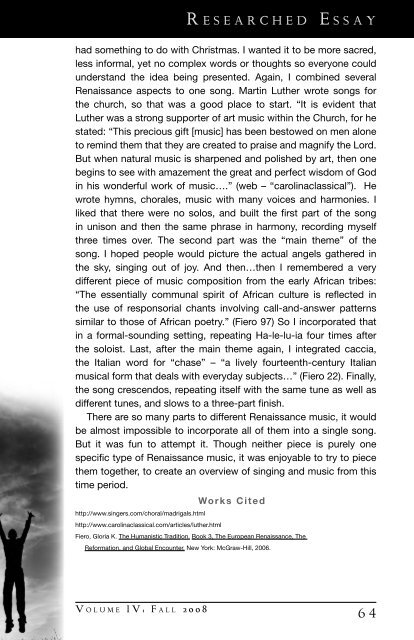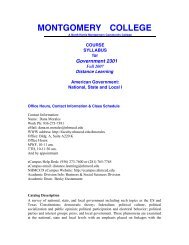2008 - Communication Across the Curriculum (CAC)
2008 - Communication Across the Curriculum (CAC)
2008 - Communication Across the Curriculum (CAC)
You also want an ePaper? Increase the reach of your titles
YUMPU automatically turns print PDFs into web optimized ePapers that Google loves.
R e s e a r c h e d E s s a y<br />
had something to do with Christmas. I wanted it to be more sacred,<br />
less informal, yet no complex words or thoughts so everyone could<br />
understand <strong>the</strong> idea being presented. Again, I combined several<br />
Renaissance aspects to one song. Martin Lu<strong>the</strong>r wrote songs for<br />
<strong>the</strong> church, so that was a good place to start. “It is evident that<br />
Lu<strong>the</strong>r was a strong supporter of art music within <strong>the</strong> Church, for he<br />
stated: “This precious gift [music] has been bestowed on men alone<br />
to remind <strong>the</strong>m that <strong>the</strong>y are created to praise and magnify <strong>the</strong> Lord.<br />
But when natural music is sharpened and polished by art, <strong>the</strong>n one<br />
begins to see with amazement <strong>the</strong> great and perfect wisdom of God<br />
in his wonderful work of music….” (web – “carolinaclassical”). He<br />
wrote hymns, chorales, music with many voices and harmonies. I<br />
liked that <strong>the</strong>re were no solos, and built <strong>the</strong> first part of <strong>the</strong> song<br />
in unison and <strong>the</strong>n <strong>the</strong> same phrase in harmony, recording myself<br />
three times over. The second part was <strong>the</strong> “main <strong>the</strong>me” of <strong>the</strong><br />
song. I hoped people would picture <strong>the</strong> actual angels ga<strong>the</strong>red in<br />
<strong>the</strong> sky, singing out of joy. And <strong>the</strong>n…<strong>the</strong>n I remembered a very<br />
different piece of music composition from <strong>the</strong> early African tribes:<br />
“The essentially communal spirit of African culture is reflected in<br />
<strong>the</strong> use of responsorial chants involving call-and-answer patterns<br />
similar to those of African poetry.” (Fiero 97) So I incorporated that<br />
in a formal-sounding setting, repeating Ha-le-lu-ia four times after<br />
<strong>the</strong> soloist. Last, after <strong>the</strong> main <strong>the</strong>me again, I integrated caccia,<br />
<strong>the</strong> Italian word for “chase” – “a lively fourteenth-century Italian<br />
musical form that deals with everyday subjects…” (Fiero 22). Finally,<br />
<strong>the</strong> song crescendos, repeating itself with <strong>the</strong> same tune as well as<br />
different tunes, and slows to a three-part finish.<br />
There are so many parts to different Renaissance music, it would<br />
be almost impossible to incorporate all of <strong>the</strong>m into a single song.<br />
But it was fun to attempt it. Though nei<strong>the</strong>r piece is purely one<br />
specific type of Renaissance music, it was enjoyable to try to piece<br />
<strong>the</strong>m toge<strong>the</strong>r, to create an overview of singing and music from this<br />
time period.<br />
Works Cited<br />
http://www.singers.com/choral/madrigals.html<br />
http://www.carolinaclassical.com/articles/lu<strong>the</strong>r.html<br />
Fiero, Gloria K. The Humanistic Tradition. Book 3, The European Renaissance, The<br />
Reformation, and Global Encounter. New York: McGraw-Hill, 2006.<br />
V o l u m e I V : F a l l 2 0 0 8<br />
6 4






